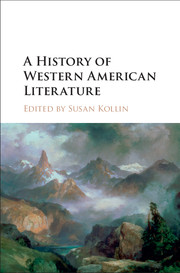Book contents
- Frontmatter
- Contents
- Notes on Contributors
- Acknowledgments
- Introduction: Historicizing the American Literary West
- PART I HOMELANDS
- PART II MAKING A REGION
- PART III GEOGRAPHIES OF THE LITERARY WEST
- 8 Literature of the Great Plains: Nature, Culture, and Community
- 9 Southwest Literary Borderlands
- 10 Imagining the Rocky Mountain Region
- 11 Writing the Pacific Northwest
- 12 The Far North: Literatures of Alaska and Canada
- 13 The Problem of the Critical in Global Wests
- PART IV THE TWENTIETH CENTURY AND BEYOND: LITERARY MOVEMENTS AND CRITICAL PERSPECTIVES
- Selected Bibliography
- Index
9 - Southwest Literary Borderlands
from PART III - GEOGRAPHIES OF THE LITERARY WEST
Published online by Cambridge University Press: 05 November 2015
- Frontmatter
- Contents
- Notes on Contributors
- Acknowledgments
- Introduction: Historicizing the American Literary West
- PART I HOMELANDS
- PART II MAKING A REGION
- PART III GEOGRAPHIES OF THE LITERARY WEST
- 8 Literature of the Great Plains: Nature, Culture, and Community
- 9 Southwest Literary Borderlands
- 10 Imagining the Rocky Mountain Region
- 11 Writing the Pacific Northwest
- 12 The Far North: Literatures of Alaska and Canada
- 13 The Problem of the Critical in Global Wests
- PART IV THE TWENTIETH CENTURY AND BEYOND: LITERARY MOVEMENTS AND CRITICAL PERSPECTIVES
- Selected Bibliography
- Index
Summary
The literary history of the region designated by the Spaniards as the northern borderlands, by residents of Mexico as la frontera, by the MexicanTexan folklorist and novelist Américo Paredes as Greater Mexico, and by residents of the United States as the Southwest might be said to begin with the Indigenous stories that recount the origins of the land and its people. One such story, told by the Diné poet Luci Tapahonso, describes the creation of her homeland by the Holy People: “When they created this world, Blanca Peak, the sacred mountain in the east, was decorated with a rainbow beam and adorned with white shell and morning light.” Mount Hesperus, in the north, “was fastened to the earth with a rainbow beam and adorned with black jet to represent peace and harmony.” She explains that cyclical restoration occurs each night when “Mount Hesperus urges us to rest. She is our renewal, our rejuvenation. She exists because of the rainbow beam. We exist because of the rainbow beam.” Tapahonso's story maps the sacred places and borders of Diné Tah (Navajo Country) as it transmits knowledge of how to live properly and cultivate the awareness of beauty in this land. It confirms a central feature of all stories of this region: attention to what the Laguna writer Paula Gunn Allen calls the “ongoing relationship, or conversation, among the human, the plant and animal, the land, and supernaturals, each perceived as members of the same geospiritual community.” It also suggests how broad the notion of “story” can be. As the Laguna novelist Leslie Silko notes in her memoir The Turquoise Ledge, for her people a story can refer to “historical accounts, village gossip, sacred migration stories, hummah-ha stories that included Coyote and the other animals and supernatural beings, deer hunting stories, even car wreck stories.” Linking deep spiritual and natural histories with contemporary experience, such varieties of storytelling can be found throughout oral and written accounts of the southwestern borderlands.
Other literary histories of the borderlands begin with the violent establishment of the U.S.-Mexico border in 1848 and trace the cultural and political effects of the land's U.S. conquest. These histories focus on the Texas-Mexico border, where Mexican citizens suddenly found themselves outsiders, los mexicanos de afuera, and writers later struggled to define the identities of Mexicans nominally integrated into the United States but dominated economically, socially, and culturally by Anglo-Americans.
- Type
- Chapter
- Information
- A History of Western American Literature , pp. 145 - 161Publisher: Cambridge University PressPrint publication year: 2015

